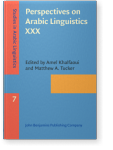On complex adjectival phrases in Standard Arabic
Yahya Aldholmi | University of Wisconsin-Milwaukee | King Saud University
Tue Trinh | University of Wisconsin-Milwaukee
In this paper, we present three puzzling observations concerning a class of adjectival constructions in Standard Arabic: (i) pleonastic definiteness, where an instance of definite morphology is semantically transparent, (ii) required resumption, where the absence of a resumptive pronoun leads to deviance, and (iii) case and agreement misalignment, where the domain for structural case assignment does not coincide with that for agreement marking. We then propose a resolution for these puzzles. Our proposal takes seriously the idea that semantics is purely interpretive, i.e. that the truth condition of the sentence is to be computed compositionally from its syntactic structure. The proposal includes two generalizations about case and agreement which turn out to concur to a large degree with widely accepted views on syntactic relations concerning these phenomena. The generalizations are (i) that arguments of 2-place predicates receive Accusative case and arguments of one-place predicates receive Nominative case, and (ii) that sentential nodes are barriers for agreement. Another conclusion of our proposal is that indices on pronouns can undergo movement which results in predicate abstraction and which exhibit properties of Ᾱ-movement.
Article outline
- 1.Presenting three puzzles
- 1.1Pleonastic definiteness
- 1.2Required resumption
- 1.3Case and agreement misalignment
- 2.Resolving the puzzles
- 2.1Accounting for pleonastic definiteness
- 2.2Accounting for required resumption
- 2.3Accounting for case and agreement misalignment
- 3.Deriving CG and AG
- 4.Extending the analysis to transitive predicates
-
Notes
-
References
References (17)
References
Abrusán, M. 2007. Contradiction and grammar: The case of weak islands (Doctoral dissertation, Massachusetts Institute of Technology).
Aldholmi, Y. 2015.
Unusual behaviors of nouns and adjectives in Arabic. A Squib, UW-Milwaukee.
Barwise, J., & Cooper, R. 1981. Generalized quantifiers and natural language. In Philosophy, Language, and Artificial Intelligence (pp.241–301). Springer, Dordrecht. 

Bobaljik, J. 2008. Where’s phi? Agreement as a post-syntactic operation. In D. Habour, D. Adger, and S. B ́ejar: Phi- theory: Phi features across interfaces and modules (pp.295–328). Oxford University Press.
Chierchia, G. 2006. Broaden your views: Implicatures of domain widening and the “logicality” of language. Linguistic inquiry 37(4), (pp.535–590). 

Chomsky, N. 2001. Derivation by Phase (MITOPL 18). In K. Hale: A Life is Language, (pp.1–52).
Fox, D. 2003. On logical form. Minimalist syntax, (pp.82–123). 

Fox, D., & Hackl, M. 2006. The universal density of measurement. Linguistics and Philosophy 29(5), (pp.537–586). 

Gajewski, J. 2002. L-analyticity and natural language. Manuscript, MIT.
Heim, I. 1982. The semantics of definite and indefinite noun phrases. (Doctoral dissertationUniversity of Massachusetts, Cambridge).
Heim, I. 1991. Artikel und Definitheit. In Arnim v. Stechow & D. Wunderlich: Semantik: ein internationales Handbuch der Zeitgenössischen forschung
, (pp.487–535 ) De Gruyter.
Kratzer, A., & Heim, I. 1998. Semantics in generative grammar. Oxford: Blackwell.
Krifka, M. 1995. The semantics and pragmatics of polarity items. Linguistic analysis 25(3–4), (pp.209–257).
Pesetsky, D. & Esther T. 2011. Case. In C. Boeckx: The Oxford Handbook of Linguistics Minimalism, Chapter 7. Oxford University Press. 

Ross, J. R. 1967. Constraints on variables in syntax. (Doctoral dissertation, Massachusetts Institute of Technology, Cambridge).
Soltan, U. 2007. On formal feature licensing in minimalism: Aspects of Standard Arabic morphosyntax, (Doctoral dissertation, University of Maryland, College Park).
Von Fintel, K. 1993. Exceptive constructions. Natural Language Semantics 1(2), (pp.123–148). 

Cited by (1)
Cited by one other publication
Al-Raba’a, Basem Ibrahim Malawi
This list is based on CrossRef data as of 29 july 2024. Please note that it may not be complete. Sources presented here have been supplied by the respective publishers.
Any errors therein should be reported to them.
